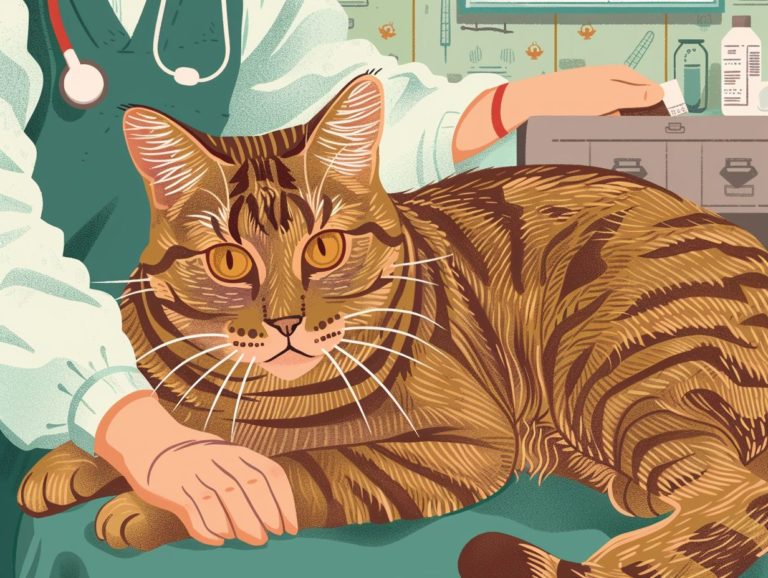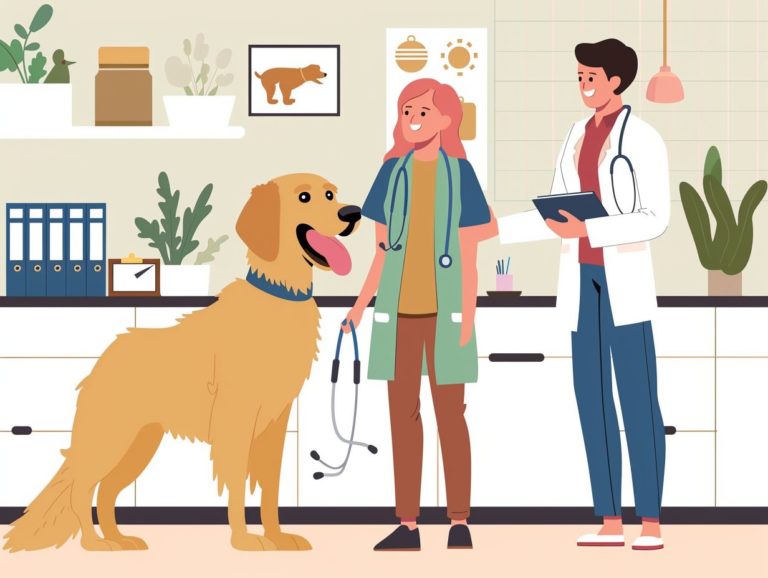Combining Health And Liability Insurance For Cat Owners Is It Worth It
This article highlights the significance of pet insurance, focusing specifically on cat owners. It delves into the different types of pet insurance available, including health and liability coverage, and emphasizes the advantages of combining both types. The article also addresses factors to take into account before combining insurance, such as coverage limits and exclusions, along with alternative options for cat owners who prefer not to merge insurance policies.
Key Takeaways:
The Importance of Pet Insurance
Pet insurance provides financial protection against medical expenses for animals, ensuring their health and safety by covering the cost of medical treatment for unexpected illnesses, injuries, and accidents throughout the insured pet’s life. Pet insurance offers pet parents peace of mind, relieving them from the worry of facing exorbitant veterinary bills and enabling them to provide necessary care for their pets.
In situations where pet owners may not have the means to afford essential treatment, pet insurance can prevent them from having to make the heart-wrenching decision to euthanize their pets due to unforeseen, life-threatening illnesses. Sudden illnesses requiring immediate treatment or surgery can incur substantial costs, potentially leading to a compromised quality of life for pets or difficult decisions for their owners.
Pet insurance plays a vital role in enabling pet owners to ensure their pets receive optimal care, even during challenging circumstances. Additionally, pet insurance covers the expenses of chronic conditions, emergency veterinary visits, and routine preventive care, reinforcing the importance of regular coverage for pets.
Why Cat Owners Should Consider Insurance
Cat insurance is important for cat owners as it safeguards them from the financial impact of unforeseen costs related to their feline companions. Whether it is an accident or an illness, cat insurance offers the policyholder peace of mind and financial security during times of need.
Cat insurance covers a range of veterinary expenses, including emergency care, surgery, medication, and specialized treatments. Owners with cat insurance can rest assured that unexpected vet costs are taken care of, alleviating a significant financial burden.
With insurance in place, cat owners can provide necessary medical care for their feline friends without having to make difficult decisions based on financial constraints.
Types of Pet Insurance
There are various types of pet insurance available, each offering different levels of coverage and cost structures to cater to the diverse needs of pet owners. These types encompass plans with differing deductibles, premiums, coverage options, and even wellness coverage provided by various insurance companies.
When assessing the different types of pet insurance, it is crucial to comprehend the variations in coverage that each type presents. Certain plans may offer higher coverage for accidents, while others prioritize preventative care or chronic conditions. The deductibles in some pet insurance plans are per incident, whereas in others, they are annual, which can influence out-of-pocket expenses.
Premiums for pet insurance are influenced by factors like the age, breed, and location of the insured pet. Insurance providers play a crucial role in assisting pet owners in navigating these options and providing comprehensive plans tailored to their specific needs.
Understanding Health and Liability Insurance
Understanding the difference between health insurance and liability insurance is crucial for making informed decisions regarding the financial well-being of a pet. Health insurance typically covers medical expenses and treatment costs, while liability insurance is primarily designed to protect owners from legal and financial liabilities.
Pet health insurance functions similarly to human health insurance by providing coverage for medical expenses. The extent of coverage varies based on the chosen plan and may include treatments for illnesses, accidents, surgeries, and sometimes preventative care.
On the other hand, liability insurance is intended for situations where a pet causes harm or damage to others, such as biting someone or damaging property.
Pet health insurance generally comes at a higher cost, with average premiums ranging from $20 to $50 per month, depending on the coverage and deductible. In contrast, liability insurance is more affordable, typically costing between $10 to $20 per month on average.
Benefits of Combining Health and Liability Insurance
Combining health and liability insurance for pets offers a comprehensive safety net for various situations. This integrated insurance covers immediate veterinary treatment for accidents and routine wellness check-ups, ensuring that pet owners can afford their pet’s medical expenses, including copays, under different coverage conditions.
This type of insurance is especially beneficial in scenarios where a pet causes unexpected injury or property damage, leading to liability concerns. With both health and liability insurance coverage, potential legal expenses or compensation claims resulting from such incidents are also included.
Comprehensive insurance can significantly alleviate the financial burden of managing your pet’s healthcare costs, allowing you to provide optimal treatment without financial worries.
Cost Savings and Convenience
Combining health and liability insurance offers enhanced and convenient coverage for pets with streamlined costs. By consolidating health and liability insurance into a single policy, pet owners can more easily manage expenses, as one policy can cover deductibles and copays, simplifying the process of filing claims with insurance providers. This integrated policy provides cost savings and convenience for pet owners by encompassing various aspects of pet care.
Pet owners can benefit from discounts and lower premiums when opting for bundled insurance policies rather than individual ones. Beyond cost savings, the policy offers comprehensive coverage for unforeseen issues that may arise during a pet’s lifetime. For instance, robust insurance can shield pet owners from high medical expenses in cases of emergencies or chronic illnesses, ensuring that their pets receive optimal care.
Factors to Consider Before Combining Insurance
Before merging insurance policies for your pets, it is crucial to understand and consider several key factors. By carefully reviewing coverage details, accident deductibles, and financial implications, cat and dog owners can assess whether combining their pets under one insurance plan is the right decision.
One of the initial aspects to focus on before merging pet insurance is the specific coverage provided for your pet. Different pet insurance policies offer varying levels of coverage, from accident-only to illness coverage to comprehensive policies. Understanding what your pet’s policy covers is essential for dog owners to determine the suitability of combining their pet insurance. Some policies may include coverage for breed-specific conditions that certain dogs are predisposed to. For cat owners, this could involve coverage for common feline conditions such as urinary tract problems or dental care.
Another important consideration is the structure of the deductible, which is the amount that needs to be paid out of pocket before insurance begins covering the costs.
Coverage Limits and Exclusions
Understanding the coverage limits and exclusions in pet insurance policies helps owners to prevent surprises and ensure they can anticipate which expenses are covered and any restrictions that exist. Coverage limits and exclusions can include conditions and restrictions, as well as veterinary fees, copays, and exclusions that are set by the insurance company.
Understanding the limits and restrictions of one’s pet insurance policy can help owners to plan for potential out-of-pocket expenses related to their pet’s health. Conditions that are often not covered by pet insurance policies include pre-existing conditions, experimental treatments, or behavioral problems. Exclusions such as routine exams, grooming, or elective procedures may have a large effect on overall insurance benefits. Understanding how vet bills are managed under specific policies, such as through reimbursement after payment or through direct billing, can help owners understand the financial components of pet care more effectively.
Alternatives to Combining Insurance
Tailoring insurance plans to meet their pet’s unique needs, pet owners can combine comprehensive insurance with standalone wellness coverage and explore alternatives such as multiple providers. Understanding the details of the claims process is essential in ensuring reimbursement for veterinary expenses.
When choosing insurance providers, it is crucial to select those that address the specific healthcare needs of the pet, whether it be for a breed predisposed to certain conditions or an elderly pet requiring specialized care. The most suitable insurance plans are those that can be customized to cater to the pet’s specific requirements.
Researching and comparing different providers can help find the right insurance policy to safeguard the well-being of a particular pet.
Other Options for Cat Owners
For cat owners looking to ensure their feline companions receive comprehensive medical coverage beyond generic insurance policies, exploring specialized cat insurance, coverage conditions, deductible structures, and vet bill management is crucial.
Specialized cat insurance plans are tailored to address the unique health needs of cats, covering common illnesses like urinary tract infections, dental issues, and chronic conditions such as diabetes. These plans offer immediate and comprehensive care without imposing a significant financial burden on owners.
Factors to consider when selecting the best insurance policy for cats include understanding coverage conditions such as annual limits and reimbursement percentages.
Frequently Asked Questions
What is the benefit of combining health and liability insurance for cat owners?
Combining health and liability insurance for cat owners provides comprehensive coverage for both your cat’s medical expenses and any potential liability issues that may arise from owning a pet.
What does health insurance for cats cover?
Health insurance for cats typically covers medical expenses such as routine check-ups, vaccinations, and treatment for illnesses or injuries. Some plans may also cover prescriptions and specialized treatments.
What does liability insurance for cat owners cover?
Liability insurance for cat owners covers any damages, injuries, or legal fees that may arise from your cat’s actions. This includes incidents such as scratching or biting someone, or causing damage to someone else’s property.
How does combining these two insurances save me money?
By combining health and liability insurance for cat owners, you can often receive a discounted rate compared to purchasing each policy separately. This can save you money in the long run.
Is it worth it to have both health and liability insurance for my cat?
This ultimately depends on your individual situation and budget. However, having both types of insurance can provide peace of mind and protect you financially in case of unexpected medical expenses or liability issues.
Are there any specific breeds or age limits for cat insurance?
Some insurance companies may have specific breed restrictions or age limits for cat insurance, so it is important to research different policies and ask questions before making a decision. Additionally, some policies may not cover pre-existing conditions, so it is important to read the fine print carefully.


